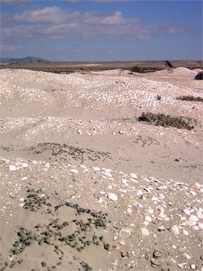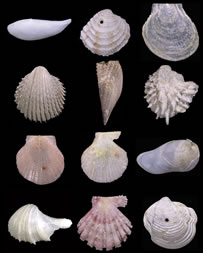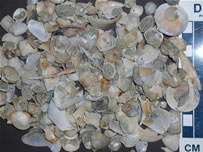Study Finds Tropics Are the Source of Most New Species
October 5, 2006
By Kim McDonald

Pleistocene age fossil deposits with abundant bivalves near Playa Ramada, Chile. Deposits such as these, and older ones, provide information about past occurrences and ages of bivalve species and lineages. Photo credit: Marcelo Rivadeneira, UCSD
Biologists from UC San Diego, Berkeley and the University of Chicago have found that the tropics are the source of a majority of the planet's biodiversity, underscoring the need to preserve tropical forests, reefs and other ecosystems around the world.
In a paper appearing in the Oct. 6 issue of the journal Science, the researchers show that for one large group of marine animals, the clams and other bivalve mollusks, about three-quarters of today's genera originated in the tropics and spread outward toward the poles, while only one-quarter originated at higher latitudes.
Other plants and animals probably have an overwhelmingly tropical origin as well, said coauthor James Valentine, a professor emeritus of integrative biology at UC Berkeley.
The finding partially answers a question that has puzzled biologists for more than 100 years: Why is there a greater diversity of life in the tropics-in both the oceans and on land-than at higher latitudes?
"These species are spilling out of the tropics and increasing the diversity in temperate and arctic regions," he said. "We should preserve the tropics, because without them, there is no source anymore for diversity in higher latitudes."
"The tropics are the engine for global biodiversity," added coauthor Kaustuv Roy, a professor of biology at UCSD. "What this means is that human-caused extinctions in the tropics will eventually start to affect the biological diversity in the temperate and high latitudes. This is not going to be apparent in the next 50 years, but it will be a long-term consequence."
Valentine and Roy coauthored the paper with David Jablonski, a professor of geophysical sciences at the University of Chicago.
The so-called "latitudinal diversity gradient" first became obvious as early naturalists and explorers returned from expeditions with more and more new species. Today, scientists estimate that there are over 10 times more species in the tropics than in the arctic, and several times as many as in temperate regions, Valentine said.

Marine bivalves show a wide array of morphologies and life habits and are a very important component of marine biodiversity. Photo credit: J. T. Smith, Scripps Institution of Oceanography
"What we were really after here was this first-order, large-scale pattern that explained what is the most dramatic single biodiversity pattern on this planet," said Jablonski. "If you came from outer space and you just started randomly observing life on Earth, or at least before people were here, the first thing you'd see is this just incredible profusion of richness in the tropics. This is the biggest pattern."
Early explanations assumed that plants and animals didn't spread much from their point of origin, and ascribed the latitudinal differences to the fact that tropical areas originate more species than do higher latitudes, making the tropics a "cradle" of biodiversity, in the words of the late UC evolutionary biologist George Ledyard Stebbins.
An alternative theory held that origination rates are similar at all latitudes, but extinction rates are higher in the north, making the tropics a "museum" of older species compared to the poles. According to Valentine, nearly every combination of origination, extinction and migration differences has been proposed to explain the pattern.
"The number of species on Earth is this complex result of the origination rate and the extinction rate at any one place, plus the immigration, just the way the population of a town is the birth rate, the death rate and the immigration," Jablonski said.
The new study is the first to provide extensive data for origination and migration rates, and shows much higher origination rates in the tropics and subsequent spreading of lineages to more northern latitudes, making the tropics both a cradle and a museum of biodiversity, the authors state.

Death assemblage of tropical marine mollusks from Panama provide a glimpse into the high species richness in the tropics. Photo credit: Susan Kidwell, University of Chicago
"I think we've killed the idea that the tropics is either a cradle or a museum of biodiversity. It's both," Valentine said. "Migration out of the tropics underlies the latitudinal biodiversity gradient. We've seen this pattern in most forms of life for a century, now we know the dynamics behind it. But we still don't know the ultimate cause. Why is the origination rate higher in the tropics?"
"The world is connected," said Roy. "It's a global village, even for organisms."
Valentine noted that greater tropical diversity has been documented for nearly all ecosystems, ranging from the deep sea, open ocean and continental shelf to terrestrial forests, grasslands and wetlands, and among plants, fungi, invertebrates and vertebrates. This biodiversity gradient has been characteristic of the Earth for at least the past 250 million years.
Despite the many theories for and against a tropical cradle or museum, not enough data on times and places of origination had been available to provide definitive tests of those ideas.
The three researchers found a gold mine, however, in the bivalves - oysters, clams, scallops and related animals with two shells - thanks to the work of Jablonski, who spent years straightening out the taxonomy, that is, the evolutionary relationships within this group. Once the living and fossil bivalves were assigned to the correct genera, the team could study the geographical distribution and first appearance of as many of the 1,300 living bivalve genera as can be traced in the fossil record. Bivalves, with their hard calcium carbonate shells, are well preserved in marine sediments.
The researchers limited their analysis to families - 174 total - in which the majority of genera were represented in the fossil record of the past 11 million years. They focused on the genus level instead of species because species are harder to trace in the fossil record. Genera, the classification just above species, "track better the novelty and inventiveness of life," Valentine said.
The team found that, among the various families of bivalves, between 57 percent and 94 percent of genera originated in the tropics. As expected, the lineages of tropical genera are younger than those at higher latitudes, reflecting the fact that the lineages originated in the tropics but took a while to migrate northward.
Valentine suspects that the greater origination rate of new species in the tropics has to do with the long and productive growing season there, versus the short season in cold and arctic regions. The harsh conditions in the north also make it harder for specialized feeders to survive. Species there tend to be generalists, able to subsist on various types of food, while tropical regions are able to support more specialists.
The work was supported by a grant from the National Aeronautics and Space Administration.
Media Contacts:
Kim McDonald, UCSD, (858) 534-7572 kmcdonald@ucsd.edu
Robert Sanders, UC Berkeley, (510) 643-6998 rsanders@berkeley.edu
Steve Koppes, U. Chicago, (773) 702-8366 s-koppes@uchicago.edu
Comment:
Kaustuv Roy, (858) 822-0559 kroy@ucsd.edu
James Valentine, (510) 643-5791 jwvsossi@socrates.berkeley.edu
David Jablonski, (773) 702-8163 djablons@midway.uchicago.edu
